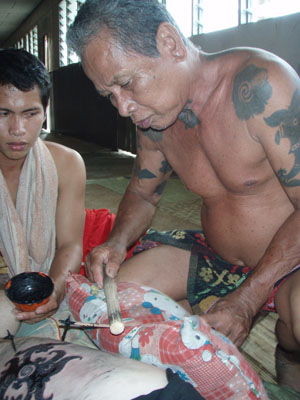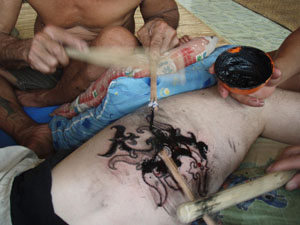by Stuart
The repetitive tapping of wood on wood which had echoed around the hallway for over 7 hours now ceased abruptly and the searing pain that had accompanied the sound began to abate. This was only a temporary reprieve whilst those who laboured on me stopped to drink and stretch aching muscles.
I opened my eyes and stared at the dozen Human skulls which peered down at me from the ceiling, I couldn’t help but wonder what series of events had put them there… how old were they?
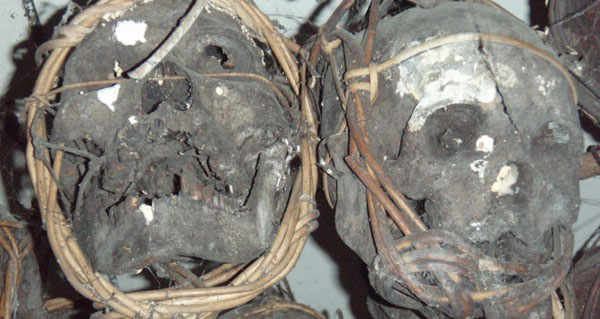
The shape of Andil’s smiling face appeared over me blocking out their gaze. I turned to look at him as he squatted next to me, the symbols that adorned his throat, shoulders, back and legs reassured me that he knew exactly what I was experiencing. His hand rested on my shoulder and with an outstretched palm he produced a small pile of rock salt crystals, I nodded in appreciation and swallowed them with gulps of water, wiping out the pools of sweat that accumulated in the depression around my eyes with the heel of my hand. Seizing the opportunity to shift position and relieve the pressure on my hip and ribs I saw that Kumbung and Sigan were ready, their instruments where back in their grip, their muscles refreshed. They glanced at me as they took up their positions, my smile was all the confirmation they needed to commence.
I closed my eyes and the rhythmic sound resumed, TapaTapahTapahTapahTapahTapahTapahTapah It’s strange how pain clarifies otherwise random thoughts into lucid daydreams…
I first saw an Iban man with a full suit of hand tapped Tattoos three years ago when I began exploring the emerald interior of Borneo. The complex maze of symbols covering the arms, chest, legs, ribs, back and throat represent a spiritual suit of armour protecting its wearer from evil spirits and making him visible to his gods, they recounted important life events, his prowess as a warrior and without them he could not successfully pass into the afterlife. Perhaps more importantly no self respecting Iban woman would marry a man who had not been on bejelai (a quest) and displayed the tattoos to prove it.
At one time the Iban were the worlds most prolific and infamous headhunters, although headhunting was made illegal well over 100 years ago, it was revived during the Japanese invasion of Borneo during WWII with the last heads reputedly being taken around 1955 - 1960 during the ‘Malayan Emergency’ and subsequent ‘Indonesian confrontation’ where the Iban fought alongside the British and Australian forces to repel communist guerrillas from the jungle.
Now such elaborate suits are becoming difficult to find, the last of the traditionally tattooed Iban are now old men in their 70s. The once proud and fearless culture of the Iban has succumbed to outside influence and religion. Christian and Muslim missionaries are still regularly encountered deep in the forest doing their self-righteous best to stamp out the last few remaining animist communities and force them to cast out the skulls taken by their ancestors.
I had arrived in Borneo prepared for a solo expedition to the upper Baram to search, as I had successfully in previous years for the last of the nomadic Penan hunter/gathers. An expedition which failed before it had even begun when I discovered that the twin otter bush planes which I had utilized last year, and on which this trip was equally dependant had ceased flying shortly before my arrival. There was talk of a new company taking up the routes but the time this materialized it would be too late.
So I found myself looking for another expeditionary task and decided to travel into the interior by 4X4 along the numerous logging tracks with an Iban called Lingi, whilst he visited his family I would go in search of the last tattooed Iban to study their tattoos and the process by which they were made.
I visited many longhouses only to be repeatedly disappointed; most were now Christian and had no interest in humouring some Orang Putay (white man’s) interests in the old ways. Even when I did successfully find old men who knew how the process was undertaken I met with disappointment when they told me that they were too old to do it anymore and besides no one had been interested in having it done for decades, it was no longer important. With time running out and disappointment setting in Lingi explained that he would have to be heading home, but he would drop me at a remote longhouse which his uncle had told him “still practiced the old ways” before setting off.
It didn’t look very promising from the outside; it was a modern longhouse with walls of concrete and a corrugated steel roof, it certainly didn’t look like the last refuge of traditional Iban life. But the welcome from its inhabitants swept away my initial doubt, children froze in their tracks with mouths aghast when they caught sight of me, young women ran inside shouting “Orang Putay!” and brought out whole families to meet me, old women took my right wrist with both hands bent double to press their foreheads to my hand. The men ushered me in and each of them brought me their own personal stash of Tuak (rice wine) for me to drink by the glass, whilst the women rushed to their kitchens to make as much food as I could eat. Every Iban longhouse I had visited in the past had treated me with a modicum of polite hospitality, but none had bestowed a welcome this intense, I was utterly overwhelmed.
It was soon established that no matter how hard they tried I simply couldn’t understand or speak Iban and so I was lead by the hand to the home of Andil Ak Uneind (Andil son of Uneind). As I was guided through the door of his bilik Andils eyes lit up, he drew himself up straight like a soldier on parade and with great effort and care he announced “Good Morning Sir!”
Andil a man in his early 70’s with a traditional suit of tattoos explained with great pride that he had been a Sarawak Ranger in the 1950s a unit made up of Iban conscripted by the British army and lead by British officers to fight communist guerrillas. His English was very deliberate and forced with each word formed by great concentration, he explained that he hadn’t spoken a word of English for almost 50 years, he also informed me that I was the first white man to ever visit this longhouse community and that not only could they demonstrate to me how the tattoos used to be done, they could actually tattoo me!
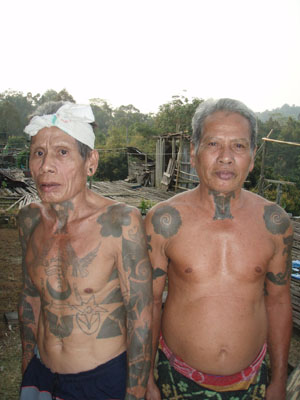
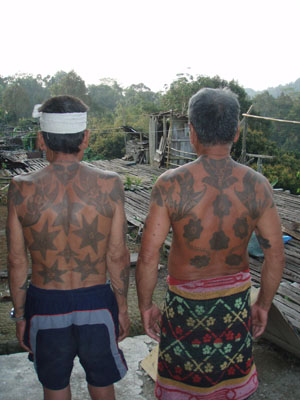
Sarawak Rangers
The opportunity to be tattooed in the traditional way, by the last of the Iban Warriors to go into battle with a spiritual armour of tattoos, the last generation of a vanishing culture. How could I refuse? My acceptance was celebrated with much drinking and feasting of boar and rice, I admired the skulls that hung from the ceiling and the entire community came to sit with me as I unpacked my belongings and passed them around, each item seemed to bring back a flood of memories for the old Sarawak Rangers, my hammock brought much amusement for the young whilst the rangers described how the British soldiers would sleep two hammocks to a tree bunk bed style one above the other and reminisced about ration packs containing sausages and bake beans, lamb and beef stews. Late into the night my mere presence continued to entertain a sizable audience, having run out items in my pack to demonstrate and given away my fire steel, I resorted to rope tricks and showing pictures of my previous travels, pictures of African Bushmen appeared to draw the most interest. Tomorrow we would start work on the designs, the old men no longer had the stamina or eyesight to do the work but Kumbung now in his 50s and his son Sigan would undertake the work, overseen by the older tattooed men.
I had decided to have the tattoo done on my right thigh, the traditional symbol for this location was the spirit symbol of the crab, which men with much discussion drew and redrew on assorted bits of cardboard, the first set of drawings they produced were so large they would have covered my entire thigh from the hip to the knee, more than a little fearful of enduring the many days of suffering required to tattoo something that large, I tore a page from a text book and explained that this was the surface area available for them work with. The men explained that tapping in the complicated crab shape that small by hand would be very difficult, but they could do it.
Meanwhile Kumbung spent the day preparing the tools required, tying needles onto the end of lengths of bamboo in groups of 3,6 and 8 and carving the hammer sticks that would drive them into the skin, oil lamps were set burning with tins suspended above them to collect the lamp soot whilst we slept, this would be mixed with honey collected from the forest to make the ink.
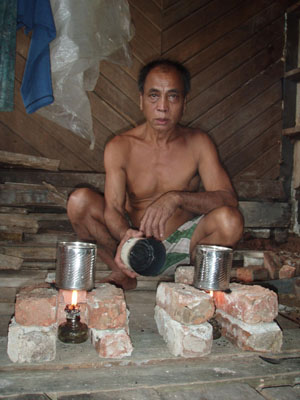
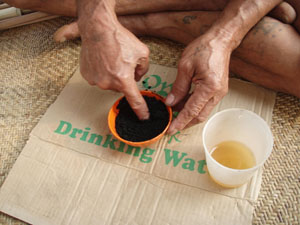
Dye preparation
With the design decided upon, the tools prepared and the lamps burning in the darkness, handfuls of betel nut and several more bottles of tuak were produced, Indicating that it would be another long night. a sudden burst of sporadic laughter emanating from a small group of elderly women weaving baskets in the gloom caught my attention, noticing my interest a young man explained “they don’t think an orang putay can take pain of pantang (tattoo), they laugh that you will run away”, “Oh” I replied with a grin, trying to hide the growing anxiety that grew in the pit of my stomach.
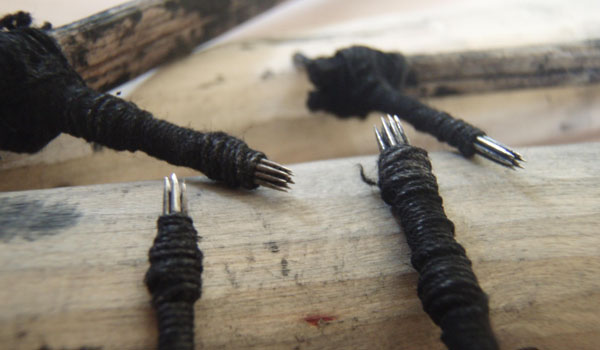
Tattoo Needles
Alone in a remote area of jungle on the other side of the world; I would place my skin and trust in the hands of these men, whom I had met only yesterday and whose language I didn’t understand, to perform a procedure they hadn’t undertaken for over half a century, in conditions that were far from sterile.
Tomorrow would begin one of the most deeply uncomfortable 9 hours of my life.
